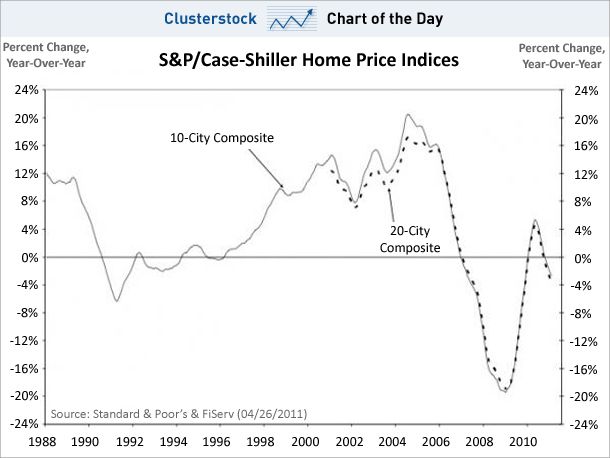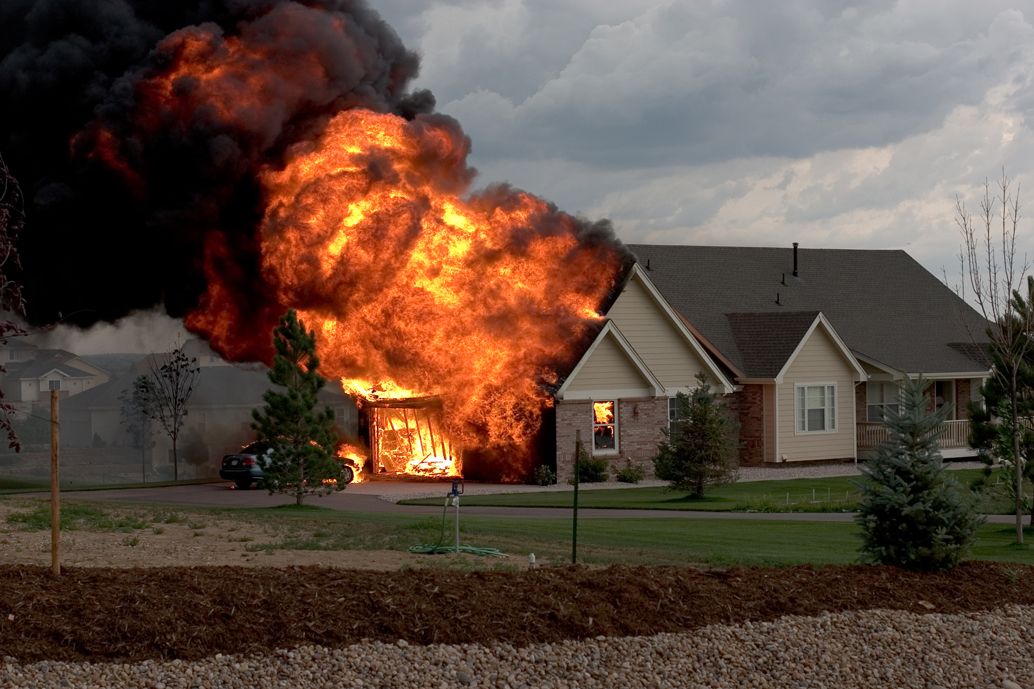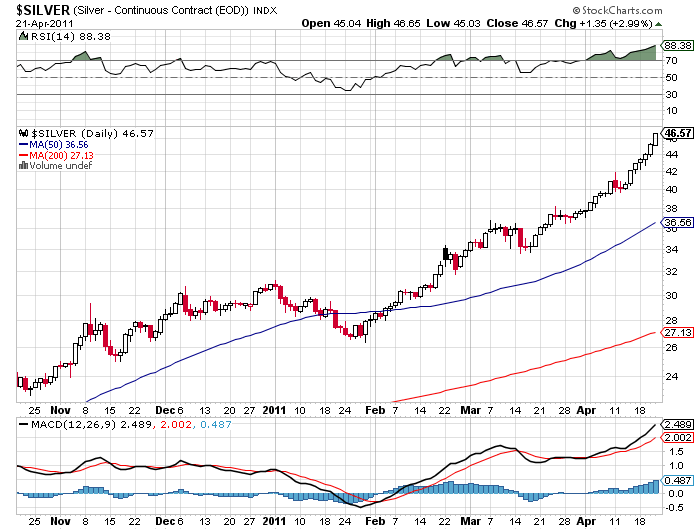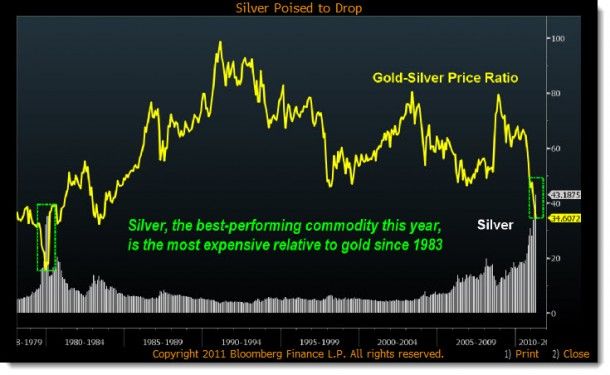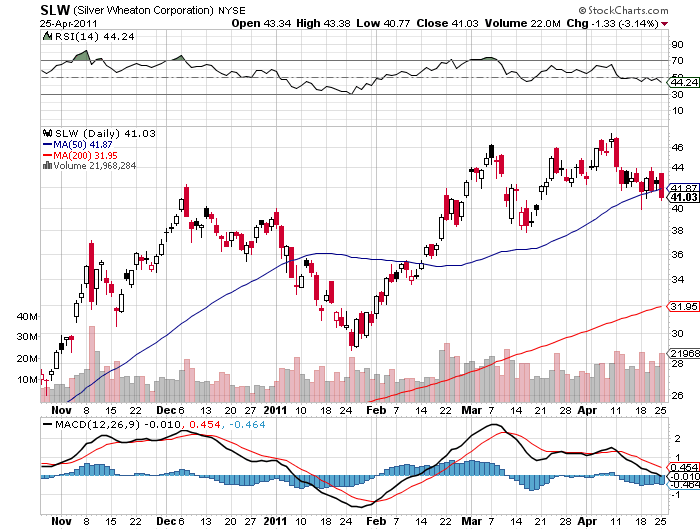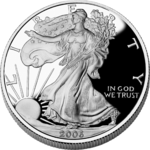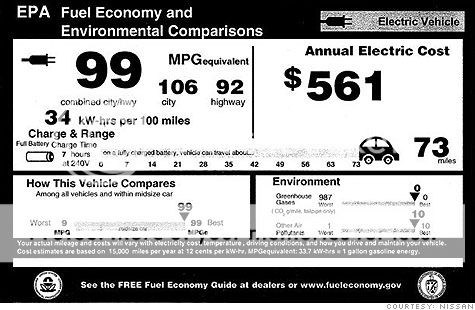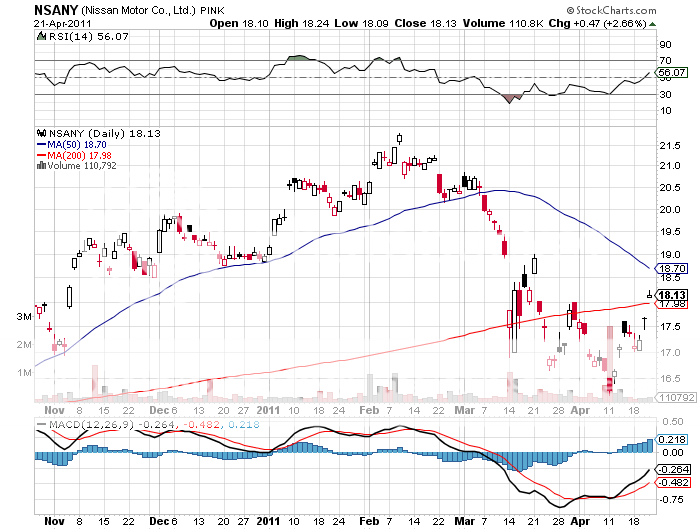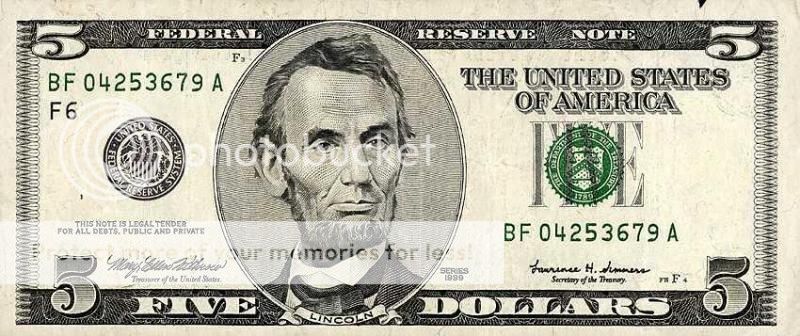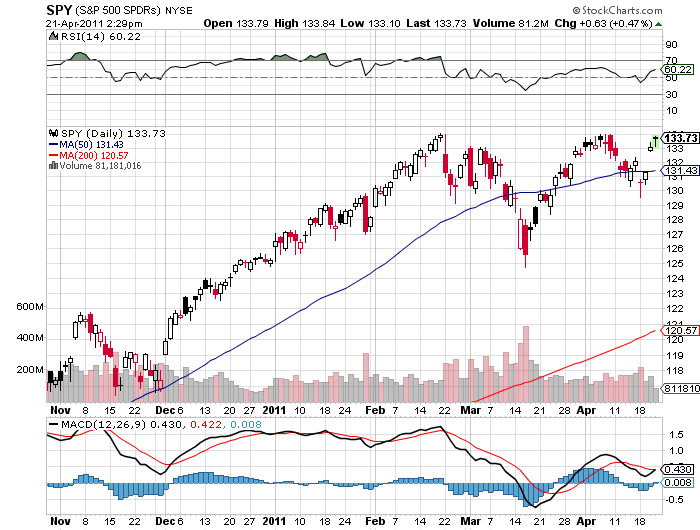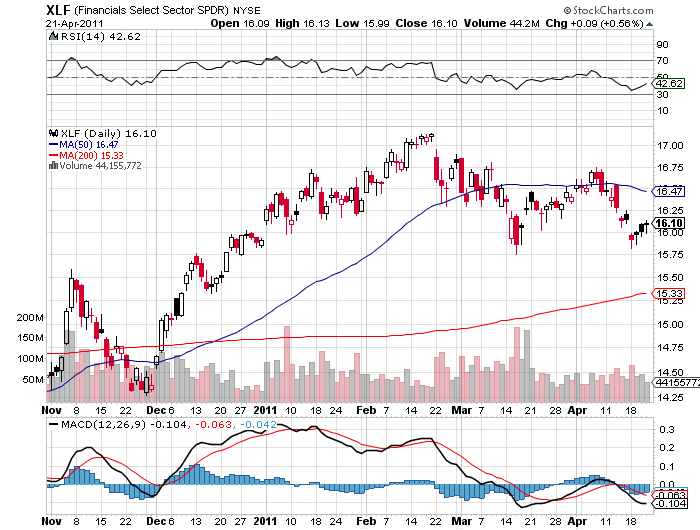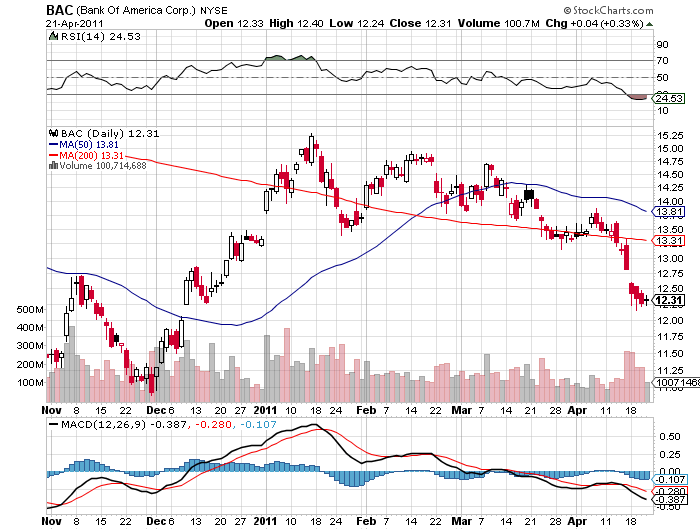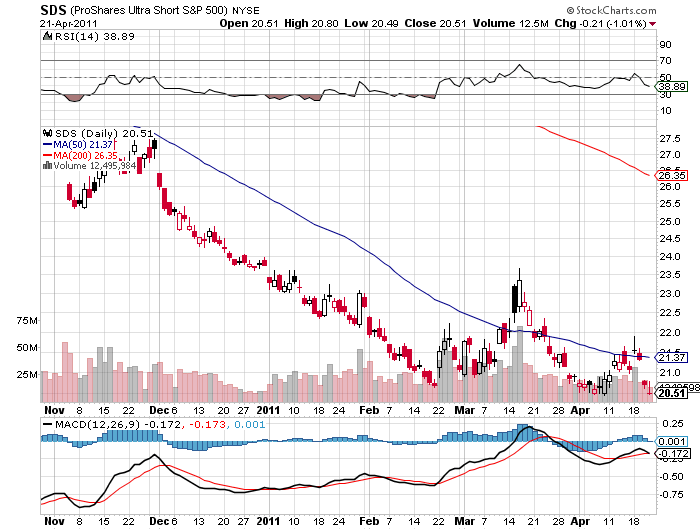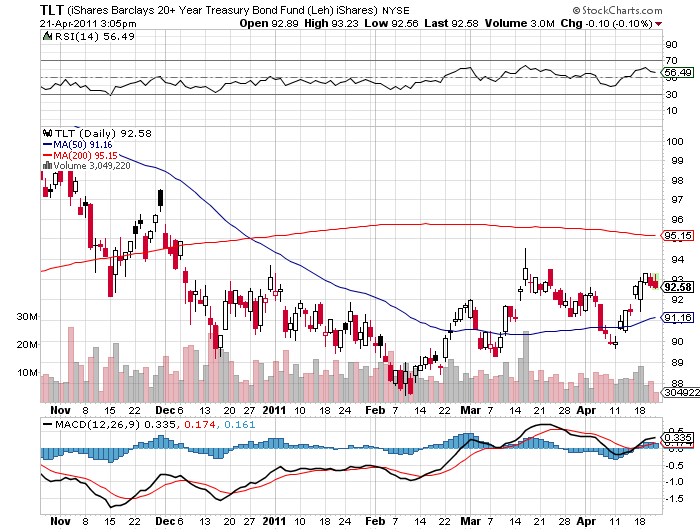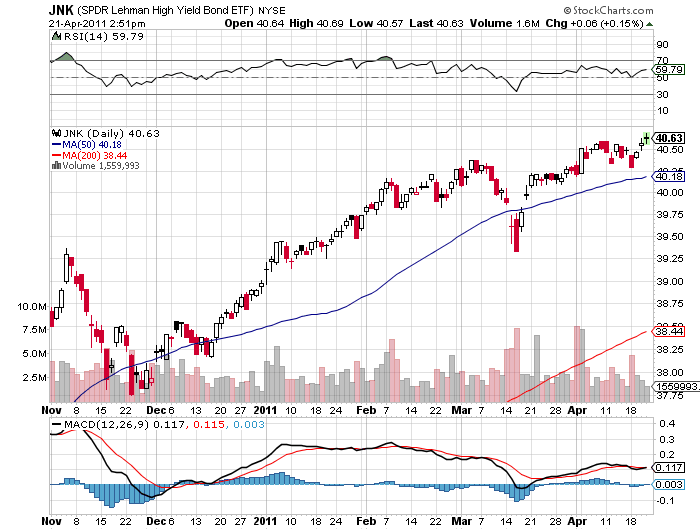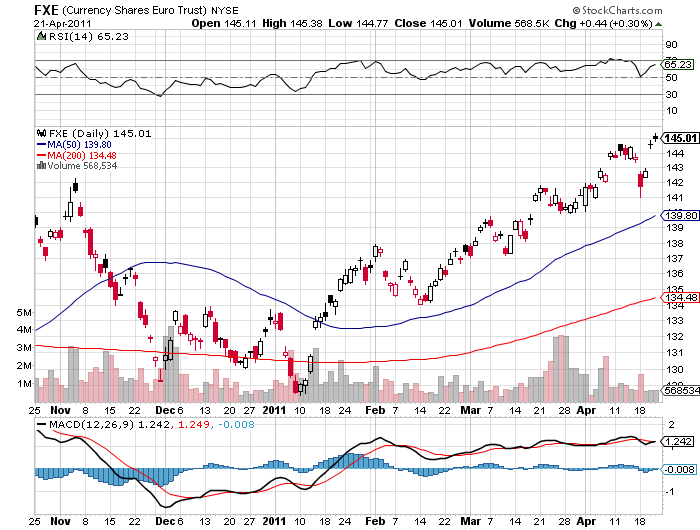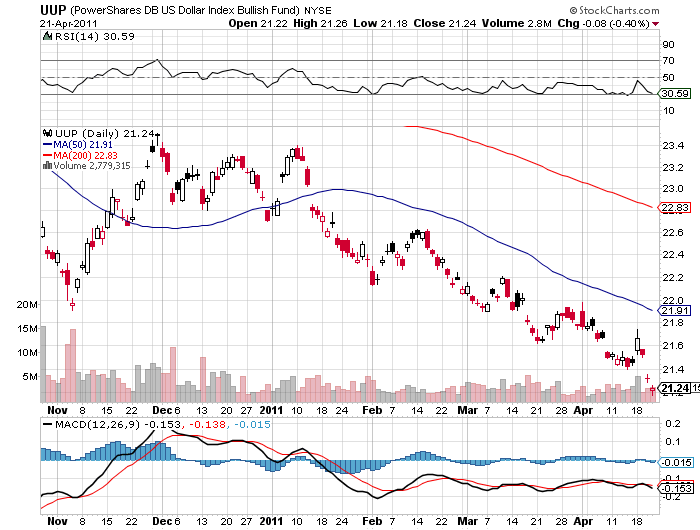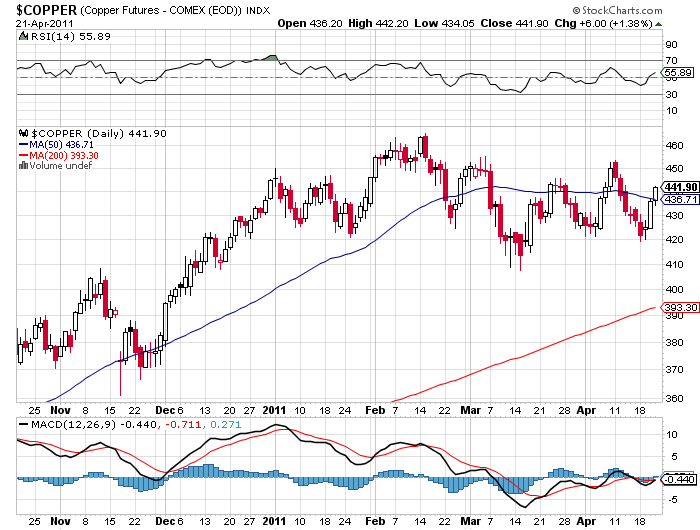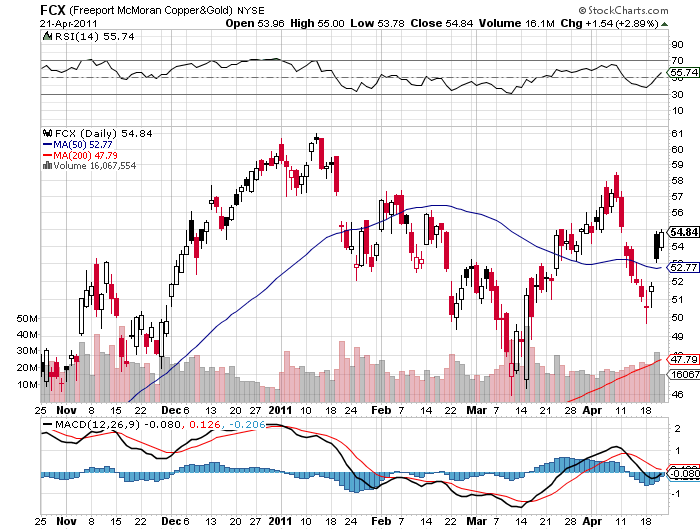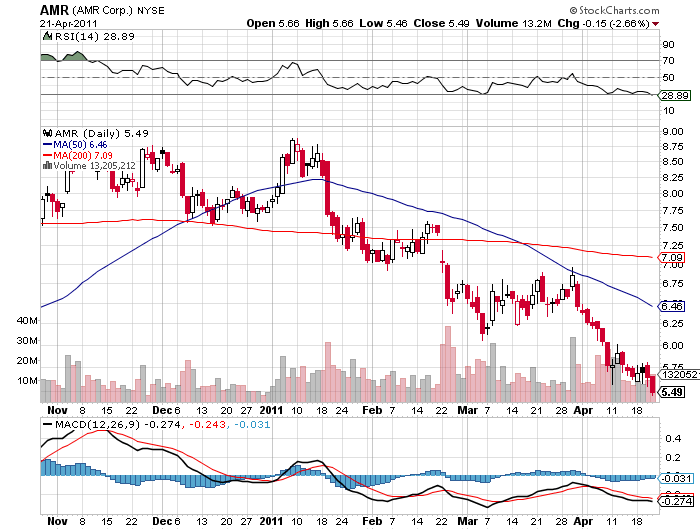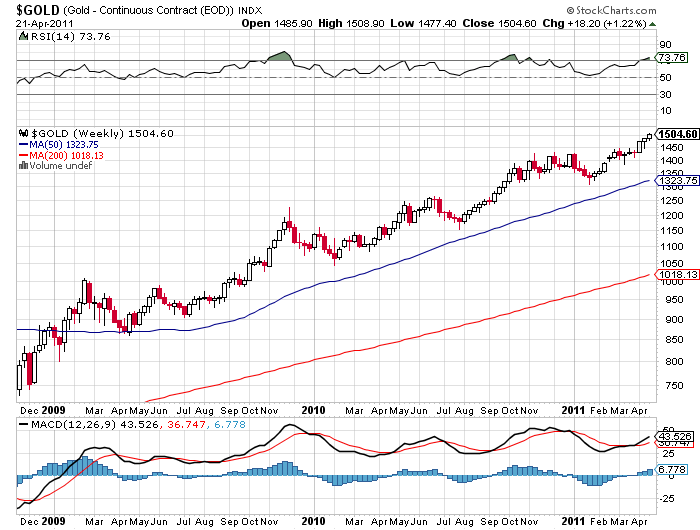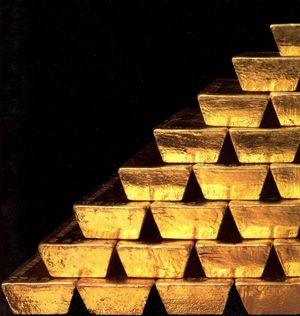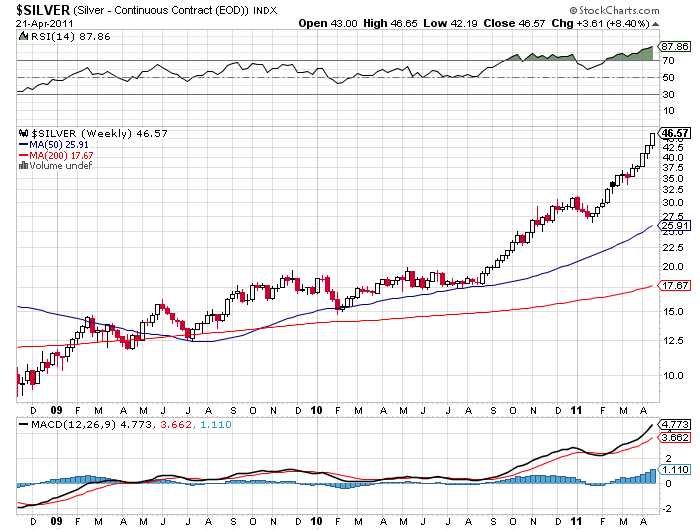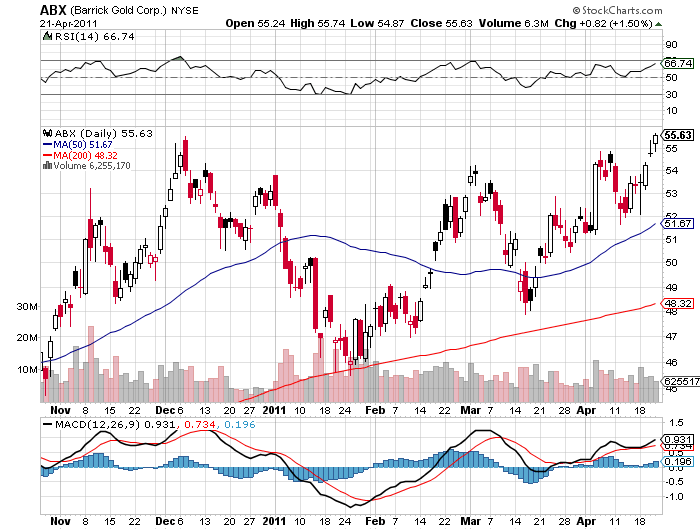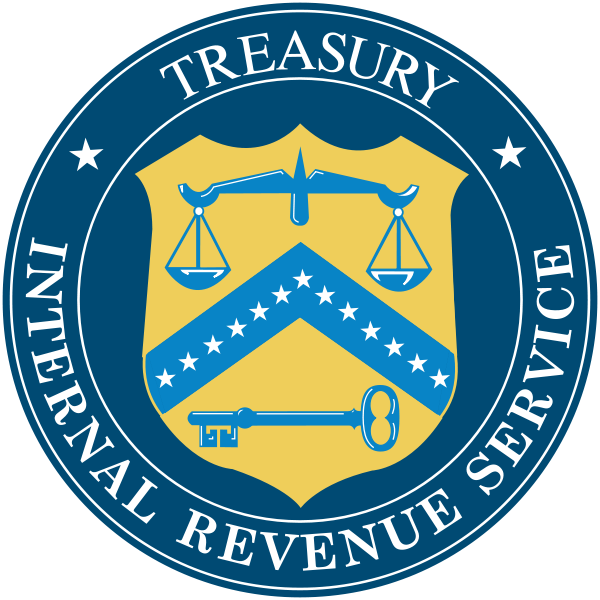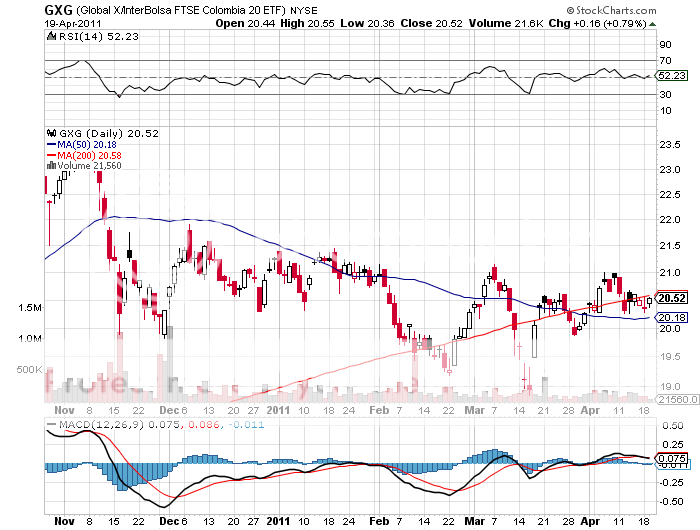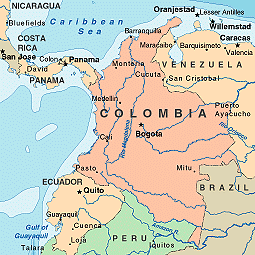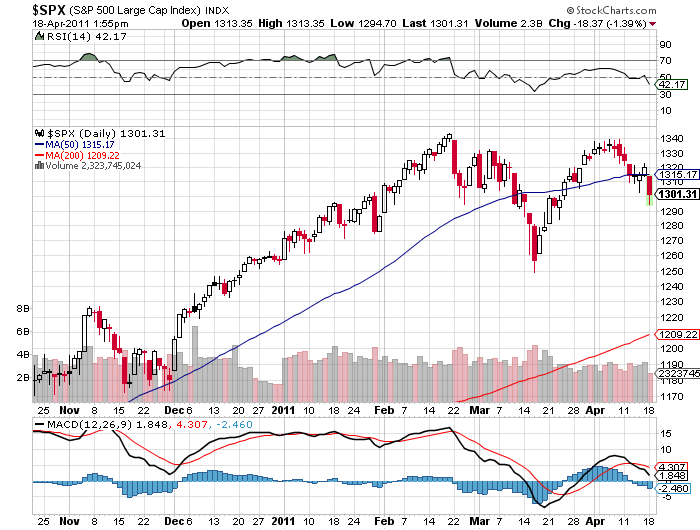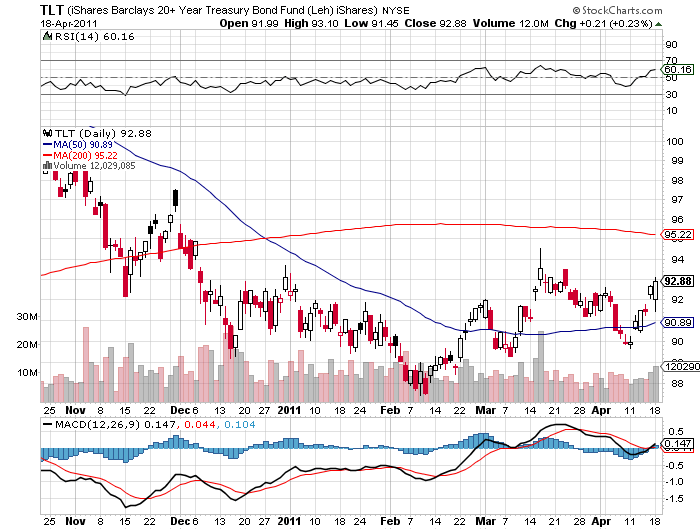
Featured Trades: (FROM BAD TO WORSE FOR RESIDENTIAL HOUSING)
2) Residential Housing Goes From Bad to Worse. That home you are sitting in while reading this letter just got cheaper. The February Case-Shiller home price index came out yesterday, showing us that the double dip in residential real estate is well under way.
Overall, the widely followed indicator showed a 1.1% month on month decline, a 3.3% drop against year ago levels, and an outright plunge from the 2006 peak of 32.6%. Some 20 out of 21 markets declined, with Minneapolis leading the charge to the downside. Perhaps this was a sick joke, but only Detroit showed a price gain last month.
The truly frightening thing about this chart is that while the greatest monetary stimulus programs in world history were underway, house prices remained comatose. Unprecedented amounts of money have poured into stocks, bonds, commodities, foreign currencies, and precious metals. While this love fest was going on, that great sucking sound you heard was money fleeing housing. If this is the best that house prices can do, what happens when the fundamentals deteriorate? These are the challenges real estate is facing going forward:
*The end of QE2
*Rising interest rates
*The end of the home mortgage deduction
*The end of subsidized government financing through Fannie Mae and Freddie Mac
*An inventory of 5 million unsold homes
*Vastly more restructure bank lending policies
*No more 'liar loans'
*A hurricane force demographic headwind. When 80 million baby boomers try to sell their homes to 65 million gen Xer's there will be more sellers than buyers for 20 years.
Bottom line: rent, don't buy
-
Doesn't Look Like a 'Buy' to Me
Featured Trades: (SILVER), (SLV)
1) My Victory Lap on Silver. 'If you don't rush out and buy silver right now at $13.70 an ounce, I'm going to pick you up and shake you by the lapels of your coat until your false teeth pop out and fall clattering to the ground.' This is exactly how I led my newsletter on May 9, 2009 (click here for the link). I reaffirmed that recommendation in my 2011 Global Forecast last January when silver was still trading only at $31 (click here for that link) . Today the white metal traded just a few pennies short of my long term target of $50 an ounce, having taken two years to get there.
My logic at the time seems positively Delphic in retrospect. The historic silver/gold ratio was 12 to 70, and with gold then trading at 65 times the price of silver, the latter seemed like a screaming buy. Today, silver is trading at a somewhat less compelling 31 times the price of gold. To reach the top end of the 100 year range it needs to rise to $124 an ounce. In the meantime, silver producers, like my favorite, Silver Wheaton (SLW), have started to flatten out.
Geologically, silver is 17 times more common than the yellow metal. All of the gold ever mined is still around, from King Solomon's mine, to Nazi gold bars in Swiss bank vaults, and would fill two and a half Olympic sized swimming pools. But most of the silver mined has been consumed in various industrial processes, and is sitting at the bottom of toxic waste dumps around the world.
Silver did take a multiyear hit when the world shifted from silver based films to digital photography during the nineties. Now rising standards of living in emerging countries are increasing the demand for silver, especially in areas where there is a strong cultural preference, as in Latin America. That set up the classic supply demand squeeze that I predicted so long ago, back when I was still wearing a '5' handle.
Now that the $50 target is a done deal, targets from latecomers that go as high as $100 an ounce abound. Tomorrow, no one would be surprised to see silver $10 higher or $10 lower. Nelson Bunker Hunt and his co-conspirator brother William Herbert Hunt, who together sparked the speculative frenzy that first drove silver to $50 some 32 years ago and were later driven into a chapter 11 filing, are probably kicking themselves today.
-
-
-
It Will Now Cost You Half a Benjamin
Featured Trades: (NISSAN LEAF), (NSANY)
3) An Update on My Nissan Leaf. I called my local Nissan dealer yesterday with some trepidation, fully expecting to be told that my new all electric Nissan Leaf sedan was buried under tons of mud after Japan's disastrous tsunami, and that I would now have to wait until 2012 for a delivery. I was pleasantly surprised when told that the car I have been waiting for 15 months for would only be delayed by another month, thanks to a shipping snafu caused by the earthquake. A ship is docking in Los Angeles next week with 125 leafs, and one of them is mine. With any luck, I should be behind the wheel by June.
I have been chronicling by odyssey to obtain a Leaf for the last two years, and final success could not be coming at a better time. Gasoline in the San Francisco Bay area is about to reach $5 a gallon. A full charge on the Leaf, which will take me 100 miles, costs $1.20, giving me an implied fuel cost of 24 cents per gallon.
Since the engine has only five moving parts, there is no maintenance cost whatsoever. Nissan has told me that in the first 100,000 miles my only expenses will be for tires and windshield wipers. The five passenger vehicle, which comes with an eight year warranty for its 600 pound battery, will cost only $25,000 after a $7,500 federal subsidy.
The delay will actually be beneficial for me because it has given Nissan time to find and fix a software glitch that kept it from starting. The company quit taking orders last year when the waiting list hit 20,000. It has resumed taking orders in the eight most environmentally conscious states (Texas is not among them), and is striving to shorten the wait time to 4-11 months. Drivers of the 500 Leaf's already on US roads say the biggest problems have been crowds of people taking pictures at the shopping mall, and the absence of plug-compatible public charging stations. (the J-1776 standard was only agreed to in 2009).
By the way, I think Nissan (NSANY) stock will be on my list of things to buy when we get the summer sell off. With global production targeted at 500,000 by the end of 2013, Nissan is going to own a market that every other car company wishes they were in.
But Which One is Mine?
-
-
-
-
Exchange This Coupon for a Free Gallon of Gas
'The rate of profit is always highest in the countries that are going fastest to ruin,' said Adam Smith, in The Wealth of Nations, on the dangers of 'overtrading.'
SPECIAL 'RISK OFF' ISSUE
THE 'ANTI QE2' PORTFOLIO
Featured Trades: (BAC), (XLF), (SDS), (TLT), (JNK), (CU), (FCX), (ABX), (AMR), (FXE), (UUP)
1) Meet the 'Risk Off' Portfolio. I believe that several asset classes are in the process of making important medium term tops, and that it is time to start building short lists of trades to execute when the big turn comes. Of course the driving factor will be the end of QE2, Ben Bernanke's massively stimulative monetary program to prevent the economy from falling back into a double dip recession.
You don't have to execute these today, this minute, or this second. But sometime in the next month, we are going to see a 'sweet spot' for a reversal in the trends we have been coining it from for the last eight months. I call this my 'RISK OFF' portfolio. You can also think of this as the 'Anti QE2' portfolio. That means taking out short positions on everything that has prospered from QE2, and buying the assets classes that have been punished severely. Like that great hedge fund manager, Wayne Gretzky, you have to aim not where the puck is, but where it is going to be. This is the next trading portfolio you should have.
When it is time to pull the trigger, the markets are going to be wild, volatile, and chaotic. So consider this a 'to do' list that I am giving you in advance. I am not predicting the end of the world here, just a three to four month summer correction in major long term trends. The 'Dow 5,000' crowd is going to have to wait until 2012 or 2013'? or go find another newsletter. I'll let you know when it is time to break the glass by sending out a trade alert.
Stocks '? Count on a three to four month sell off bottoming sometime in August, when summer liquidity is at a low ebb. Unload whatever long positions you have left and start piling on the downside exposure. The chip shot here is to buy the (SPY) August $130 puts. That is the April low, and is the first place that nervous investors will start paying up for downside production. My initial target will be the March low of $125, and below that the November low of $118 if the market really gets the bit between its teeth. ETF players may want to look at the double short fund (SDS).
If the bond market continues to stabilize or rise, as it has done for the past month, it will eat into the free lunch that the banks have been feasting on for the past two years. That does not auger well for the financials, whose chart looks like they have already entered a downtrend. A short position or some puts in Bank of America (BAC) stock may net you a few bucks from here.
-
-
-
-
Don't Aim Where the Market is Now, But Where It's Going to Be
-
Bonds- US Government bonds have been punished mightily since rumors of QE2 first surfaced among hedge fund traders last summer, taking the yield on ten year Treasury bonds from 2.35% to 3.9%. In the run up to the end of QE2, yields have since backtracked down to 3.40%. The demise of the program will drain $75 billion a month of net buying from the market, prompting many analysts to predict an utter collapse in bond prices.
I think the opposite will happen. Any generalized selling of assets will create a flight to safety bid for Treasuries that will more than offset the Fed absence, stabilizing prices, and possibly driving them higher. I'm not looking for a new bull market in bonds, just a slow grind up of a handful of points. So an intelligent play here might be to use dips in bond prices to sell short the September out of the money puts and take in the premium income. I have already done this with the June puts, and it has been one of my most profitable trades of the year.
A better idea might be to sell short junk bonds. High yield corporate debt is now selling at a mere 300 basis point premium over Treasuries, close to an all-time low, and a far cry from the 2300 basis point spread we saw in the dark days of 2008. This is a market that has covered an awful lot of ground in a very short time, entering positively bubblicious territory. If the stock market turns to the downside, junk bonds will follow close on its heels.
The no brainer here is to either sell short the (JNK) outright, or buy the September (JNK) $40 puts, which today were selling for $2. My initial target for these would be $37 or more if you get an expansion of put premiums on the downside, which I expect.
-
Junk Bonds Are a Sell Here
-
-
Foreign Currencies-No asset class has suffered more from QE2's massive expansion of the monetary base than the US dollar. Ben Bernanke's decision to freeze the Federal funds rate at near zero, while the rest of the world has ratcheted up rates, has proved a death knell for the greenback. It would be a vast understatement to say that this has become a one sided trade, with positions in the futures markets betting against Uncle Buck at record highs. This has become every trader's free lunch.
We all know how this story ends. When too many traders pile into one end of the boat, it capsizes. Think of stretching a rubber band to its limit and waiting for the snap back. The next chapter in this story has to read that the rest of the world pauses with their rate rises, while the US plays catch up, possibly later in the year. The first round of profit taking in the 'RISK ON' assets of stocks, commodities, oil, precious metals, and foreign currencies is certain to trigger a flight to safety bid for the dollar. Then those huge, hot speculative positions in the dollar come tumbling down.
Most over extended on the upside has been the Euro, which seems to want to go higher as its fundamentals worsen. The move from $1.28 to $1.46 has been accomplished with a mere 0.25% rise in interest rates, and some impressive jaw boning by European Central Bank president Jean-Claude Trichet. Never mind that the PIIGS are at or near bankruptcy, most European banks have a negative net worth when their cross holdings of sovereign debt are marked to market, and that Europe's economy is growing at half America's rate, and a tenth of China's. Short dated out of the money puts on the euro ETF (FXE) make sense here. You can also go long the dollar against a basket of currencies through the (UUP).
-
-
Are These Shorts?
-
Commodities- Copper has been warning us for some months now that things are starting to roll over in basic commodities land. Traders call the red metal 'Dr. Copper, the only commodities that has a PhD in economics, because its record in predicting the outlook for the economy has been so accurate. Get a decent 'RISK OFF' trade going, and copper prices will plunge. Drop copper prices, and the world's top producer, Freeport McMorRan (FCX) also gets a bloody nose. The play here is to buy puts on a copper ETF like (CU) and (FCX) itself.
Any serious drop in commodity prices will be followed closely by a drop in oil, too. A large part of today's oil buying is to use it as a dollar alternative. Give a bid to the buck and that buying disappears in a heartbeat, causing the price to give back $30 quickly. Who is the biggest beneficiary of falling fuel prices? I am thinking, 'Fly Me, Jane'. Buy the airlines, especially one that has a low ratio of hedging fuel prices forward in the futures market, and is therefore most sensitive to changes in the prices of Texas tea. That would be the old legacy carrier, American Airlines (AMR), which is amazingly still in business.
-
-
-
Precious Metals-No asset class has benefited more from Ben Bernanke's profligacy than the precious metals. Since rumors of the program were mulled over last August, gold has risen by 31%, while silver has rocketed by an eye popping 174%. No one has been a bigger fan of the white metal than me, who suffered from boatloads of abuse when I first recommended a buy at $10 in December of 2008.
But there is not a trader on the street who doesn't think that the metal hasn't entered the final parabolic stage of its move, and that prices at these levels are insane. No one would be surprised to come into work tomorrow morning and see silver down $10. Look for silver to tickle the old 1979 Hunt brothers high of $50 an ounce, and then suffer a very rapid $10 bout of profit taking. If you don't believe me, check out the chart below, which shows two 20% pullbacks in silver in recent months. Only participate through deep out of the money short date puts, like around the $42 strike, as the risk here is high. If you don't like riding roller coasters with your hands up in the air, buy some puts on leading gold producer Barrick Gold (ABX).
-
Looking a Little Toppy to Me
-
-
-
And Then There's the 'E' Ticker Ride
'The greatness of America lies not in being more enlightened than any other nation, but rather in her ability to repair her faults,' said French observer Alexis de Tocqueville in his 1835 book Democracy in America.
Featured Trades: (THE COMING TAX HIT)
2) Get Ready for Your Tax Hit. No matter what anyone promises you today, this week, or this year, your taxes are going up. At $1.3 trillion, the budget deficit is so enormous that bringing it into balance merely through spending cuts is a mathematical impossibility. Chopping funding for Planned Parenthood and National Public Radio just isn't going to do it.
If you own your own home, work for a large company, save for your retirement, earn money from capital gains, and put in a check when they pass the dish around at church every Sunday, you are the biggest beneficiary of the current tax system. You are about to take a big hit. Check out the hit list below, and the tax revenues the death of these tax breaks will raise:
$264 billion- Should those without health care subsidize those who receive it for free from their employers? This is the amount raised by taxing company provided health insurance as regular income.
$100 billion- Should renters be subsidizing homeowners? Kiss that home mortgage interest deduction on loans under $1 million goodbye. Ditto for the real estate market as a whole.
$100 billion- End the tax deductibility of charitable contributions. Should those who don't go to church subsidize those who do? Universities, churches, and political fund raising take a big hit.
$52 billion- Should those without savings subsidize those salting away money for retirement. This is the argument that will be made to end tax deductibility of 401k contributions.
$39 billion- Savings on taxes exempted by the step up in the cost bases for investments inherited by surviving spouses. She doesn't need that McMansion anyway.
$36 billion- Tax capital gains as regular income.
$31 billion- Stop special tax treatment of dividend incomes.
Please note that these most draconian measures only raise $586 billion a year, a mere 45% of last year's deficit. Without raising tax rates, the remaining $714 billion will have to come from cutting Medicare, Medicaid, Social Security, and Defense spending. In any case, I think it will be politically impossible to get any of these changes through the current congress. An energy tax and a national value added tax are on the table.
None of these hikes would be necessary if the economy grew at a 7% real rate instead of 3%. This is why tax rates in emerging countries are so low. But I believe that America's long term growth rate is falling, not rising, and that our budget problems are going to get worse, not better. What happens if interest rates rise for the world's largest borrower?
Of course, we could adopt Mary Meeker's suggestion in yesterday's piece on USA, Inc. and eliminate all deductions, raising about $1 trillion a year. That would involve shrinking the Internal Revenue Code from the current 100,000 pages to a single page, and moving to a flat tax system. The mass unemployment of one million CPA's and 106,000 internal revenue agents alone would be worth the price.
About to Join the Unemployment Lines?
Featured Trades: (REPORT FROM LIBYA)
1) Report from Libya. Over the weekend, I managed to catch up with a friend of mine who just escaped from Libya by the skin of his teeth. Sent there by an oil major to explore for deep water oil and gas in the Gulf of Sidra, he spent the first few weeks of the revolution staying at his home in an expatriate compound in Tripoli, out of harm's way.
When he went out to forage for food, a car with four rebels pulled up alongside. One said 'If you want to save your life, leave.' He managed to grab a seat on one of the last flights out of the country before the coalition attack, carrying just a handbag. The next day the fighting spilled over into his neighborhood. A week later his employer sent someone to see what was left. The entire compound had been looted, stripped bare of anything of value, and all the cars were stolen. My friend had lost all his worldly possessions.
He is now on an extended vacation awaiting a new assignment, and filling out compensation requests, which the company has promised to make whole.? I asked him exactly how much oil really was in Libya. He said that his firm had succeeded in finding commercially viable gas deposits off shore. But the government demanded such aggressive terms for further development that there was nothing left for the company.
The majors were ready to walk away from Libya even before the recent troubles started. Perhaps this is why the attack went forward so quickly. The real potential in Libya was in the older fields inland which had yet to benefit from modern technology. But the Khadafy regime had yet to permit access to these areas.
In the meantime, the company is keeping 125 local staff on the payroll, in case there is a quick return to Libya. How the personal department manages this without a functioning banking system in the country is beyond my imagination. But oil majors have the world's most sophisticated and competent managements, so I image they'll somehow pull it off. A new regime will certainly be much more open to dealing with foreign companies. And after all, Khadafy is only president for life.
There Goes the Company Car
-
You're Only President for Life
Featured Trades: (COLUMBIA), (GXG)
3) Columbia is Popping Up on My Radar. My current scenario for global equities has them selling off over the summer, then a rebounding led by emerging markets starting sometime in the fall. In that case you want to start building short lists of high growth countries to pile into, once the turn comes.
I would be including Columbia on any such list. It enjoys that sweet spot of being an oil exporting emerging country whose shipments hit an all-time high OF 884,000 barrels a day in March, about half the quantity that Libya once shipped. The quality of the government has improved dramatically over the last decade. It is a narco state no more, although public and investors' perceptions lag deeply. The country has seen upgrades by leading credit agencies. Billionaire Carlos Slim, the world's richest man, has recently been seen as a major investor.
The country also enjoys one of the world's most favorable demographic pyramids. A young, upwardly mobile workforce is producing a rising tide of consumers and a burgeoning middle class, while expensive seniors requiring social services and medical care are few and far between.
Columbia was the world's best performing equity market in 2010, bringing in gains of over 100%. That was how the country ETF (GXG) performed. Is history about to repeat itself?
-
-
Featured Trades: (MACRO MILLIONAIRE PERFORMANCE)
1) Macro Millionaire Portfolio Blasts to New All-Time High. Followers of the Mad Hedge fund Trader's Macro Millionaire model portfolio hit an all-time high on Friday, reaching a five month return of 25.35%. That compares to a much more modest return of 10% for the S&P 500, and 0.05% for cash. It also puts the trading mentoring program in the top 1% of all hedge funds. According to the research boutique, Hedge Fund Research, the average hedge fund brought in a gain of only 1.6% in the first quarter of 2011.
What pushed us over the top was the unexpected rally in the Treasury bond market last week. While most analysts were expecting a selloff of Biblical proportions in the waning days of Ben Bernanke's QE2, I was willing to bet that bonds would do nothing, at least for now. And nothing was exactly what we got. That allowed the June puts on the Treasury bond ETF (TLT) that I sold two months ago for $1.02 to close at $0.35 on Friday, adding 3.77% to our total return. If I run this position all the way into expiration on June 17, it will add 5% to our portfolio.
The early Macro Millionaire followers were stunned by their initial performance from the end of November, 2010, with big longs in financials, commodities, the grains, and energy, and shorts in the Treasury bond market producing immediate double digit profits. This enabled Macro Millionaire to become the fastest selling new trading program available on the Internet. I was busier than the proverbial one armed paper hanger, tracking the markets, pumping out trade alerts, responding to readers' questions, delivering strategy luncheons, and working my 40 year accumulation of industry contacts for everything it was worth.
Recent months have been quiet ones for Macro Millionaire traders, as global market began a medium term topping process in February. A short volatility position in the bond market seemed the only low risk, high return trade out there. I leave high risk, low return ideas for competing newsletters to promote. Premature short positions in the yen and the euro cost us a few bucks and a lot of frustration, but at the end of the day, 19 out of 21 realized and unrealized trades have been profitable.
I have a feeling that our brief period of inaction is coming to an end. A global risk reversal appears to be at hand, and a plethora of trading opportunities are about to present themselves. With only a single position in short bonds tying up margin, we have more than ample dry powder to take advantage of sudden opportunities.
If for some reason you have suffered the misfortune of missing the Macro Millionaire trading program until now, let me address that shortfall. Just send me an email, and I'll send you the details about this unique, and highly profitable mentoring program at madhedgefundtrader@gmail.com . With any luck, you'll cover its $2,000 a year cost on the first trade, and then more.
-
-
Meet the Proverbial One Armed Paper Hanger

